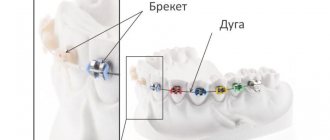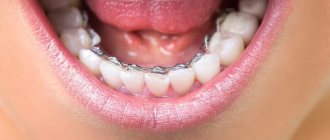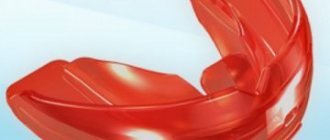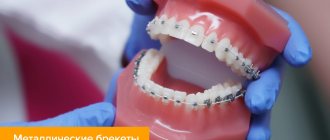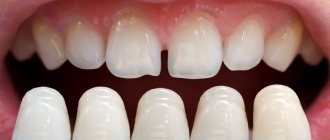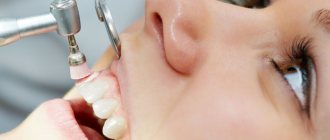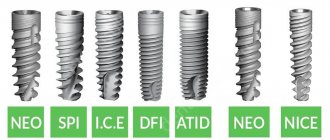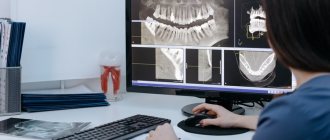Consequences of installing braces
The benefits of braces are undeniable. These orthodontic products are actively used to correct various dental defects. However, if used incorrectly, braces can cause harm. Before installing them, the doctor will definitely tell the patient about possible negative consequences (which are often temporary). These include:
- Unpleasant feeling in the mouth . This is a normal reaction to the appearance of a foreign object in the oral cavity. As a rule, it takes 2-4 weeks to get used to braces. The first days are the most unpleasant, but very soon you will feel relief and then you will get used to it.
- Toothache . The main task of braces is to move and/or rotate the tooth into an anatomically correct position. Accordingly, as the tooth dislocates, the soft tissues are slightly injured. Pain occurs. In most cases, it is mild and aching in nature. In rare cases, the patient has to take painkillers.
- Increased salivation . This symptom will also have to be endured, since it is temporary. The appearance of a foreign body in the oral cavity is a signal for increased salivation. After a few days, saliva production returns to normal.
- Impaired diction . Those who are forced to work for the public suffer the most. On the other hand, such people especially need to take care of the beauty of their teeth. So we have to make such “sacrifices”. Note that this problem is also temporary. You adapt to new conditions very quickly.
- Problems with gums . Some patients may initially experience minor inflammation on their gums caused by braces. This is easy to deal with. It is enough to rinse your mouth with special solutions and use anti-inflammatory gels. But if the inflammation is caused by insufficient hygiene when wearing braces, then the treatment will be more complex and lengthy. Sometimes in such cases the doctor removes the braces ahead of schedule.
- Psychological consequences of braces . Many people develop complexes. They feel embarrassed to smile. They cover their smile with their hand or simply try not to open their mouth. From the outside it looks strange and not aesthetically pleasing. Today, you won’t surprise anyone with braces, so you shouldn’t be ashamed of them.
- Caries after braces . Be carefull! The most important and difficult task after installing braces is to keep your teeth and mouth clean. This should be done after every meal. If you neglect this rule, then caries appears very quickly.
- Damage to teeth . This is a rare complication that occurs due to improper stress on the teeth. As a rule, such problems can arise when the crown part of the teeth is shortened.
Also, other side effects (usually temporary) are possible from braces, depending on individual characteristics. The doctor will tell the patient about this.
Medical Internet conferences
Relevance. The dental system has undergone significant transformations in the process of evolution. This is directly related to changes in the human diet. This is mainly reflected in the shortening of the length of the jaws, the reduction of the third large molar. All this leads to a lack of space for the eruption of permanent and sometimes baby teeth. As a result, various types of pathological bites and anomalies in the position of teeth arise. The prevalence of dental anomalies ranges from 11.4 to 71.7%, which depends on the methodological level of research, professional training of doctors, and representativeness errors [6]. In this regard, to solve these problems, the relevance of the issue of installing bracket systems, which have not only positive properties, but also negative ones, is growing. It is necessary to study the impact of braces, both local and general, in order to minimize the disadvantages and maximize their advantages using innovative technologies.
Purpose: to study the effect of braces on the dental system and the occurrence of changes in the body as a whole.
Tasks:
1) study the effect of braces on the spine, organs of vision, explain the appearance of headaches;
2) identify what changes occur in tooth tissue, periodontal tissue, and bone tissue.
Materials and methods. An analysis of scientific articles, journals, and dissertations on this topic was carried out.
Results and discussions. Correction of pathological types of occlusion, anomalies in the position of teeth in the upper and lower jaws is an important problem for the dentist. However, when installing fixed orthodontic structures, patients experience general complaints: headache, impaired posture, vision, and possible manifestation of astheno-vegetative syndrome. All these symptoms arise due to transformations in cranial-sacral biomechanics, which are caused by fixed orthodontic appliances [3]. There is a close relationship between all organs of the maxillofacial region, which manifests itself in morpho-functional unity [6]. This determines the fact that when one link of this system is influenced, changes occur in the entire dentofacial complex. Thus, when installing braces, a kind of cascade of reactions is triggered: teeth-dentition-jaws-bones of the skull-muscles of the neck and spine [5].
Tension of the muscles of the neck and spine leads to such general disorders as changes in posture and headaches. A more detailed pathogenesis of headaches is explained by the fact that when the neck muscles are overstrained, tension in the scalp muscles occurs, which leads to attacks of so-called tension headaches.
The connection between the dentoalveolar system, the muscles of the shoulder girdle and the spine determines changes in the stabilometric indicators of the functional balance of the human body and, as a consequence, a change in the center of gravity entails a violation of posture, which occurs in 71.4% of patients undergoing orthodontic treatment [3].
When using braces, bone tissue is rebuilt in the area of the sutures of the skull. In this case, overstretching of the lateral group of neck muscles is noted. This leads to compression of the external and internal carotid arteries. In this case, there is a deterioration not only in blood flow, but also in its outflow. The brain is under ischemic conditions for a long time. Oxygen starvation is the cause of astheno-vegetative syndrome, which is manifested by rapid fatigue and memory impairment. These complaints occur in 93.7% of patients [3].
In addition, vasospasm and cerebral ischemia significantly impair the trophism of the optic nerves. This leads to gradual deterioration of vision in 31.8% of patients [3].
After the installation of braces, various negative processes occur in the dental system. These include changes in the hard tissues of the tooth, periodontal tissues, and bone tissue of the alveolar process.
Elements of the bracket system make it difficult to carry out high-quality oral hygiene, the mineralizing function of saliva and microhemocirculation in periodontal tissues change [4], local and humoral immunity is disrupted [1], and the quantitative composition of the microbial flora increases. All this contributes to the accumulation of soft dental deposits and the formation of dental plaque, which can subsequently give rise to the development of a carious process.
Fixing and changing various elements of the bracket system, etching, grinding and polishing enamel can cause dental hypersensitivity (DSH) in patients. A long-standing problem of HCH can leave its mark on the patient's behavior (for example, the requirement to perform anesthesia even before the simplest non-invasive procedures) [3].
After installing braces, oral diseases such as gingivitis and periodontitis may occur. The development of the inflammatory process in periodontal tissues is usually associated with deterioration of oral hygiene during orthodontic treatment, incorrect choice of orthodontic design, and the initial state of periodontal tissues and hard dental tissues [2].
When the braces system affects the dentition, deformation of the jaws occurs, a long, complex process of restructuring the bone trabeculae is observed, bone tissue resorption in the place where the tooth should not be and its formation in the place where the tooth needs to be “moved”. The result of an incorrect choice of orthodontic design or errors in the placement of the bracket system can result in the occurrence of a pathological bite and incorrect jaw relationship.
Braces also affect the condition of the temporomandibular joint (TMJ). After installing braces, an unusual feeling of discomfort appears, excessive pressure on the dentition, hypertonicity of the masticatory muscles, which can contribute to the occurrence of pain and crunching in the TMJ.
Also relevant is the question of the patient’s quality of life after removing braces. Positive results include obtaining a functional, aesthetic and morphological optimum. A negative result is the occurrence of relapses, that is, a gradual return of the bite to its original state. This is due to the fact that after the braces are removed, the new position of the teeth is based not on bone, but on cartilage tissue. Only after this tissue has been converted into bone can the treatment be completed. The quality of the results of active treatment, in turn, is associated with the treatment methods used and the algorithm for their application. As a result, patients have to continue treatment using other removable and non-removable structures. If you do not consolidate the result, then we can assume that the long process of wearing braces is completely useless.
Conclusions:
1) braces have both positive and negative effects on the dental system and the body as a whole;
2) general changes are observed in the spine, namely, this is a process of changing posture, changes occur in the muscles of the neck, which leads to decreased vision, tension headaches, fatigue and memory impairment;
3) local effects include changes in tooth tissue, periodontal tissue, as well as in bone tissue;
4) based on this analysis, we can say that with the correct approach of the patient to treatment with fixed orthodontic appliances, as well as after their removal, subject to many rules and instructions from the doctor, the negative effects of using braces can be avoided and only positive results can be obtained.
Consequences after removing braces
Consequences of braces are possible even after they are removed. Possible problems include:
- Stains on enamel . This effect is possible due to poor hygiene. Teeth whitening and remineralization will help correct the situation.
- Changing the shape of the face . This is a very rare occurrence. And if the patient experiences drooping of the cheeks or changes in the nasolabial folds, then the defects are quickly restored with the help of special gymnastics.
- Demineralization of enamel . Another potential disadvantage of braces is the weakening of the enamel. This is due to the fact that under the structure the hard tissues of the tooth did not receive enough of the necessary microelements. To minimize the risk of such a complication, courses of treatment to strengthen the enamel (remineralization) are prescribed after braces.
- The teeth returned to their previous position . To prevent teeth from moving apart after braces, the patient needs to wear retainers for some time. These are special orthodontic splints that are placed on the teeth to secure the result.
Pros and cons of braces according to doctors' reviews
Real reviews from doctors about the pros and cons of braces boil down to the fact that the main advantage of these devices is their ability to correct even the most complex malocclusions, unlike other orthodontic devices, and the disadvantage is the difficulty of care and aesthetic qualities (with the exception of certain types of braces) . In addition, experts do not advise choosing braces based on numerous tables on the Internet, which compare treatment periods for different types of braces and prices for these designs. Why?
Firstly, every patient must understand that the degree of impact on the teeth and the duration of the correction process are the same for all braces. This is due to the natural mechanism of tooth movement. Secondly, the following can be said about the cost of braces. There are clinics that offer expensive sapphire braces for the price of ceramic ones. And it's not a joke. It’s just that the cost of orthodontic structures and services for their use depends on the pricing policy of dentistry, and not on the quality of braces or the qualifications of the doctor. Therefore, in our article we will, of course, talk about approximate prices for this or that type of braces, but, basically, we will evaluate bracket systems according to the following criteria:
- aesthetics;
- reliability;
- comfort of wearing;
- ease of care.
Interesting fact!
According to rumors, scientists at Oxford University are working on creating magnetic braces. They say that the principle of their operation will be based on the creation of a constant magnetic field using two miniature generators, which will act on the iron contained in the teeth and effectively correct the bite without the need to wear any structures.
Causes of problems
Negative consequences of braces most often occur when medical recommendations are not followed, namely:
- poor oral hygiene;
- consumption of foods that are undesirable during treatment with braces;
- non-compliance with other medical recommendations (they are individual for each patient).
Problems when wearing braces can also arise due to weakened immunity and some individual characteristics of the body. It is important to consult a doctor in a timely manner to eliminate current disorders. Before installing the structure, the doctor weighs all the pros and cons of such treatment, taking into account the patient’s characteristics.
Elimination of design defects
Depending on the cause of the rubbing, the patient can help himself or seek help from a doctor. You can do the following yourself:
- Use wax. Special orthodontic wax can be purchased at a pharmacy. Usually, in the first two weeks, all owners of braces use it, with a few exceptions. A small amount of wax is rolled into a ball and attached to that place in the system that, upon contact with the mucous membrane, provokes discomfort. The wax can be removed before eating. After brushing your teeth or rinsing your mouth, use a new ball. Paraffin is also suitable, but using chewing gum is strictly not recommended: individual fragments of it get into hard-to-reach places in the structure and are then very difficult to clean out.
- Arm yourself with toothpicks. The displaced “tail” of the metal ligature can be returned to its place with a toothpick. The tip of the wire is bent under the arc so that it does not touch the cheek or lip.
In the following two cases, you cannot do without the help of an orthodontist:
- Lengthening the metal arc. Excess arc length must be removed. The protruding fragment is cut off or bitten with tweezers so that its length does not cause damage to the mucous membranes.
- Detaching the bracket. The loose lock must be returned to its place by fixing it with glue. To do this, you need to clean the enamel surface from plaque and stone, etch the place where the lock is fixed with acid, then fix the bracket and attach a power arc to it.
Myths about the negative consequences of braces
We talk about the most common misconceptions regarding complications when wearing braces.
Braces lead to tooth decay
Braces do increase the risk of caries, but only if hygiene rules are neglected. To prevent caries from forming under braces, the products are fixed using orthodontic glue, which also has protective properties against the enamel.
After installing braces, the doctor will tell the patient how to brush their teeth properly. To do this, you will need dental floss, special brushes, and an irrigator. This cleaning will remove any food particles that may be stuck between the elements of the orthodontic structure.
Braces change the color of the enamel
After braces are removed, the areas of the teeth where the glue was applied may differ in color. But this is a temporary phenomenon. The patient undergoes professional cleaning and resurfacing. The natural color of teeth is restored and evened out within 2-3 weeks.
Braces cause crooked teeth
Everything is exactly the opposite. Braces straighten the teeth, particularly in cases of abnormal bite. And this is the main purpose and benefit of these structures. Problems arise when the patient refuses retainers. These are temporary orthodontic splints that are placed to prevent teeth from moving apart again.
Interdental gaps appear after braces
A gap between teeth after braces may appear for a short time until retainers are installed. After installing the splints, the teeth are in the correct position and the gap disappears.
Braces damage your gums
Gum problems after braces occur in approximately 4% of patients. Most often, the reason for this is insufficient hygiene or uneven chewing load (which was incorrectly calculated when installing the structure).
Braces cause headaches
Sometimes I get headaches after getting braces. This is a relatively rare side effect that is temporary. This problem can be solved after getting used to the design.
Gum inflammation
During and after orthodontic treatment, the patient begins to notice that while wearing braces, his gums have receded. Inflammation of soft tissues occurs due to poor dental care, lack of vitamins or incorrectly installed orthodontic system. You also need to understand that after tooth extraction there may also be inflammation of the gums.
In rare cases, a complication of wearing braces is gum recession and exposure of tooth roots.
In most cases, the inflammatory process in the gums while wearing braces begins due to poor hygiene. Braces make the cleaning process more difficult, which often leads to plaque deposits and tartar formation. As a result, problems begin, the gums bleed and hurt. The same symptoms can be observed after braces are removed.
A more rare reason is incorrect installation of the orthodontic system or its manufacturing errors. In these cases, braces can injure the gums, after which inflammation begins. If, some time after installing an orthodontic system, you notice that your gums are swollen, pain, and bleeding appear, then it is better to visit an orthodontist. This is necessary to eliminate the possibility of incorrect position of the braces.
A similar situation can be observed after braces are removed for the same reason - weakening of the gums occurs as a result of the accumulation of plaque, which is a breeding ground for various bacteria and pathogenic microorganisms.
It is important to recognize inflammation in the early stages and go to the orthodontist so that the doctor can prescribe treatment. When wearing braces, it is important to regularly brush your teeth twice a day and after every meal, and the use of an irrigator is recommended.
Features of proper care
To prevent teeth from deteriorating after braces, it is important to follow basic oral care rules. These are 3 key recommendations:
- Proper hygiene . If you have braces, then from now on you won’t be able to get by with just a toothbrush. In addition, special brushes, small brushes, dental floss and mouthwash are also used. It is also advisable to use an irrigator to wash the oral cavity. Such hygiene is necessary to prevent caries, so that teeth do not deteriorate.
- Power control . Braces are a fairly fragile structure that can be damaged by hard foods, such as nuts, crackers, hard cheese and others. Avoid such foods, as well as sticky foods. If a breakdown or deformation of structural elements suddenly occurs, you should consult a doctor as soon as possible. It is contraindicated to remove braces on your own.
- Examinations with a doctor . In addition to the emergency cases described above, you also need to regularly go to the doctor for preventive examinations. Most often this is once a month, but an individual schedule is drawn up for each patient.
What to do if the bracket comes off?
In itself, this happens quite rarely, only in cases of severe crowding of teeth, since the arch puts a lot of pressure on the dentition and the lock falls off. Another option is if the patient is a nut or other solid food lover.
If you find a broken bracket, contact your orthodontist immediately. Otherwise, the teeth will begin to gradually move to their original position. Also remove elastic bands if you wear them.
The doctor sees patients with unstuck braces out of turn. It takes about 5 minutes to glue a new lock.
It also happens that the archwire flies out of the bracket grooves. You can try to get it back yourself. However, this should be done extremely carefully, without damaging the adjacent locks.
Restoring enamel after braces
The aesthetic consequences of braces can be successfully eliminated using the following procedures:
- professional cleaning;
- teeth whitening;
- installation of retainers with a special composition that strengthens the enamel;
- polishing and processing of enamel with special solutions.
Methods for correcting bite
The simplest method is to prevent malocclusion. That is why it is not recommended to remove baby teeth before they fall out on their own; it is preferable to install special crowns or removable dentures on them, which will prevent the growing teeth from moving and will hold space for them.
Unfortunately, it is not always possible to prevent the problem and sometimes doctors have to correct an already broken bite. In this case, only one treatment method is possible, namely braces.
Everyone has heard or read about them, almost everyone has seen one or another device in the mouth of someone they know, but few people know that modern braces are very far from those terrible brackets and plates that were used at the dawn of orthodontics.
Modern brace systems differ from them not only in appearance, but also in the materials used and installation method.
FAQ
How does the oval of the face change after braces?
The face after braces becomes more symmetrical and proportional. This is a consequence of correcting the bite. For example, if a patient’s teeth do not close together and the face appears elongated, then after correction with braces the cosmetic defect is eliminated. Most often, after such treatment, the cheekbones become more expressive and the cheeks become sunken.
Is it possible not to wear retainers after braces?
Can. However, the consequences of such a decision are difficult to predict. The teeth will again try to return to their previous position. And then, 1-2 years of correction with braces will be useless.
Do braces make your lips look bigger?
Visually, yes, because there is a bracket arch under the lip. However, after removing the structure, the effect of lip augmentation disappears.
Do teeth fall out from braces?
No, they don't fall out. And information about this is just rumors that have no basis.
Type of braces
Lingual
- completely invisible.
- as durable as metal systems.
- are more expensive than ceramic braces.
- They are more difficult to maintain than labial systems, which are attached to the outside of the teeth.
- significantly affect diction.
Of course, the above pros and cons of braces will play an important role in shaping your preferences regarding one or another type of these orthodontic structures. However, we will tell you a secret: the best braces for each patient will be those that will help him solve his particular bite problems. Therefore, an experienced and knowledgeable orthodontist will help you choose the right bracket system after examining and diagnosing your teeth.
What types of braces are there?
The two main types of braces are external and internal braces. The first ones are installed on the outer surface of the teeth, and the second ones on the inner surface (so-called lingual braces).
Braces can be made from a variety of materials, ranging from metal and ceramic to precious metals and sapphires. Of course, this does not change the effectiveness of treatment, but, for the taste of some patients, braces made of gold with sapphires pleasantly amuse one’s vanity and look more aesthetically pleasing.
Popular brands of ligature braces
Brand systems Alexander, Clarity
Global manufacturers are releasing more and more new lines of brands that have differences in design. The most famous and popular brands:
Alexander (Ormco, USA) – metal ligature bracket system made of high-quality steel; a very popular model with narrow locks; the design is effective in treating any anomalies, comfortable to wear: the adaptation period is quick and painless; the price is high.
Clarity Advanced (American company 3M Unitek) - made of high-quality durable ceramics; the locks are small and do not create problems during the adaptation period; patients are always satisfied with the aesthetic appearance of the structure; average price category.
Brand Inspire ICE
Inspire ICE (Ormco, USA) – a very beautiful, transparent model that shimmers when illuminated; durable, but also fragile, like all sapphire structures; The disadvantages are increased fragility and high price.
Radiance (American Orthodontics, USA) - made of translucent sapphires, almost indistinguishable in color from tooth enamel, therefore completely invisible when smiling; expensive models.
Pumo (Ortho Technology, USA) – made of sapphires treated with zirconium, which gives the model additional strength; the cost is lower than previous models.
Spirit MB (American company Ormco) - models made of plastic on a metal base; light, beautiful, comfortable; the disadvantages are a possible change in color and insufficient strength, and therefore the design is used to eliminate simple defects; quite expensive, but the best model in its segment.
Plastic braces from Ortolite, Russia are of lower quality than the previous ones, but they are light, beautiful and inexpensive models.
Who is suitable for ligature braces?
When carrying out treatment, the orthodontist conducts a preliminary examination of the patient, after which he analyzes the data obtained and decides on the possibility of installing braces.
Installation of ligature braces is indicated for:
- various malocclusions;
- crowding and curvature of units of the dental system;
- the presence of large gaps between teeth – diastema and three;
- impacted or unerupted teeth due to lack of space – promotes the movement of teeth and their normal eruption;
- violation of the facial contour due to various anomalies of the dental system;
- atrophy of the jaw bone and reduction of interdental spaces in preparation for prosthetics or implantation.
Contraindications are divided into absolute and relative. The absolute ones include:
- severe osteoporosis - fragility of bones due to the loss of bone tissue minerals, especially calcium;
- decompensated (with unstable blood sugar) diabetes mellitus;
- congenital and acquired (AIDS) immunodeficiencies;
- bone tuberculosis;
- edentia – toothless jaw;
- bruxism;
- oncological processes after radiation or chemotherapy;
- severe psychoses.
Relative (eliminable) contraindications:
- chronic periodontitis and periodontal disease in the acute stage;
- caries and its complications;
- any acute and exacerbation of chronic pathological processes.
Ligature braces - what are they?
This is an orthodontic design in which there is a metal bracket (arc) connected to braces-locks on the teeth. The bracket is threaded through the groove of each lock, combining them into a single system. Each lock in the ligature bracket system is attached to the arch with ligatures. They can be in the form of rubber or wire rings. The structure is installed so that the bracket determines the vector of movement of the dentition units. For adult patients, clear or white elastic bands are used. Multi-colored rubber bands will suit your child as an additional decoration.
Despite the fact that today more advanced types of braces with self-regulating elements are being produced, the classic ligature version is still popular because of its reliability. In addition, this is a less expensive correction option.
The history of bite correction goes back many centuries. The first prototype of modern types of braces appeared only in the 17th century in France: the court dentist Pierre Fauchard straightened teeth using a plate tightly tied to the dentition with strong threads. Many specialists tried to contribute to the creation of the desired design, but only at the end of the 19th century a real breakthrough occurred: the American dentist Engle created a device based on the force of an arc. Since then, the design created by Engle has been constantly improved.
